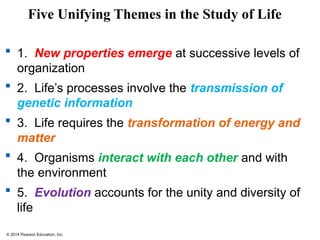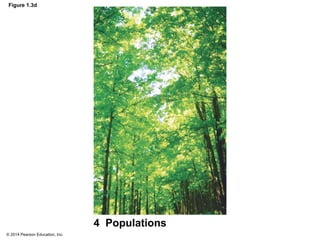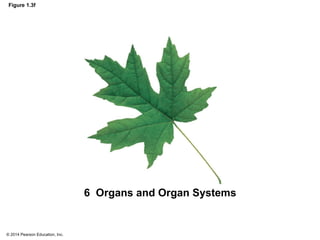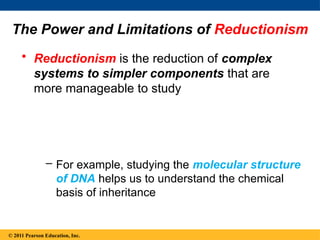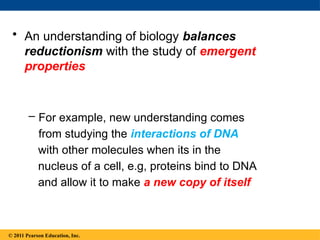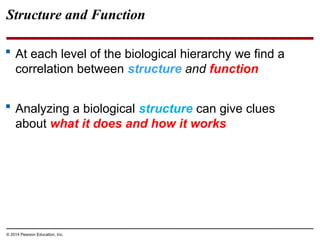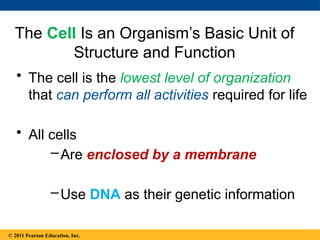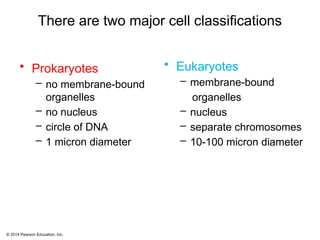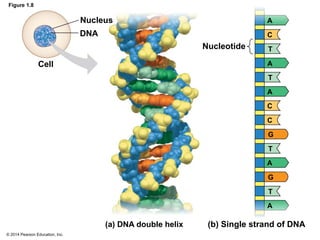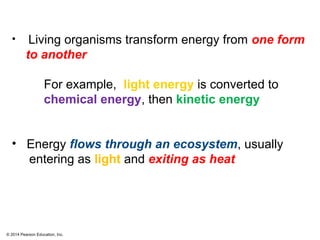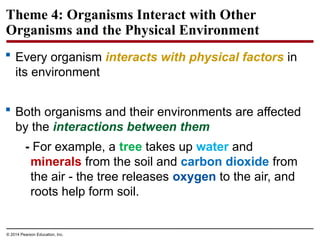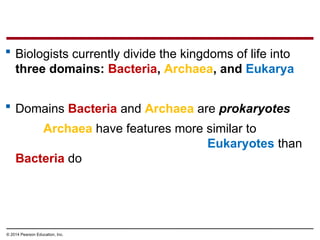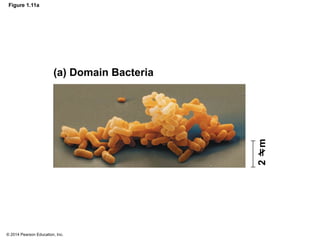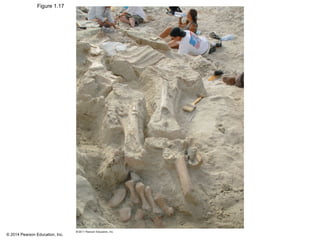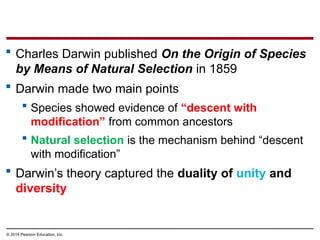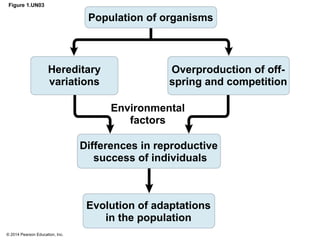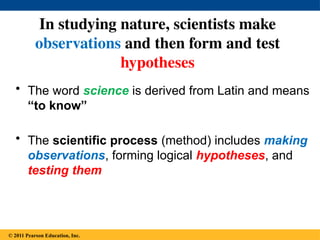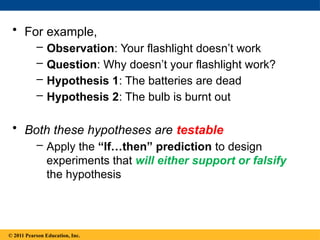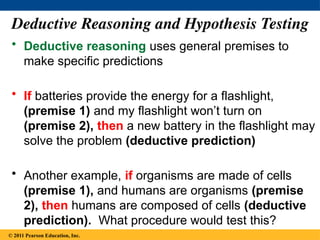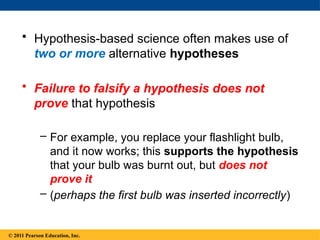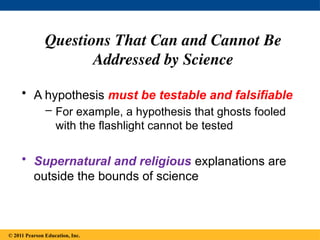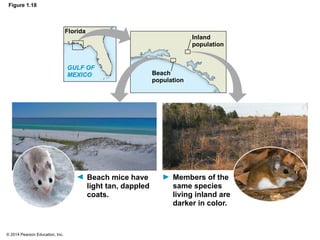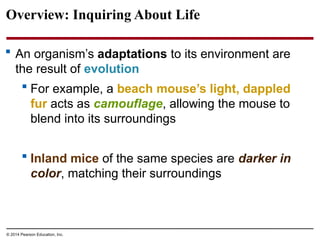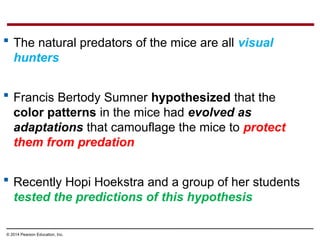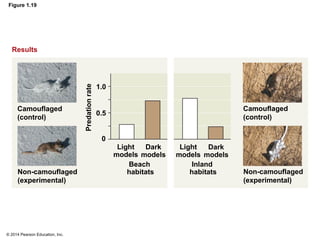More Related Content
Biology in Focus Chapter 1 01lecturepresentation 150831030832-lva1-app6891 01 Lecture BIOL 1010 30 Gillette College Exploring Biology (Biology Is the scientific study of life).ppt Exploring Life - Biology Chapter Education 01-exploring biology text.ppt Biologi Dasar: A Hierarchy of Biological Organization Similar to 112edited_01_Lecture_Presentation_PCAJS.pptx (20)
Chapter 1 exploring life.Campbell 01themesinthestudyoflife-130311053223-phpapp01.pdf Tiếng Anh chuyên ngành Sinh học [01 lecture presentation] Ch 1: Themes in the Study of Life campbell_1.ppt chapter 1 exploring life. 01_Lecture_Presentation.ppt ap biology 10 01_Lecture_Presentation.ppt 01_Lecture_Presentationthemesin the study.ppt Introduction Themes in the Study of Life.ppt Lesson 1: The Grand Journey into the Study of Life - An Introduction to Biology 01themesinthestudyoflife 130311053223-phpapp01 01 introduction to biology Biological presentation by Joel Haisa M251342F Recently uploaded (20)
Type 2 Diabetes Mellitus (T2DM) Part 3 v2.pptx AWMI case presentation ppt AWMI case presentation ppt Integrating Traditional Medicine with Modern Engineering Solutions (www.kiu.... periodontaldiseasesandtreatments-200626195738.pdf المحاضرة الثالثة Urosurgery (Inflammation).pptx Critical Issues in Periodontal Research- An overview Man & Medicine power point presentation for the first year MBBS students Tuberculosis : NTEP and recent updates (2024) FMCG-October-2021........................ ANTI-HYPERTENSIVE PHARMACOLOGY Department.ppt Peripheral Arterial Diseases PAD-WPS Office.pptx sexual offense(1).pptx download pptx ... Tackling Intensified Climatic Civil and Meteorological Aviation Weather Chall... Nematodes - by Sanjan PV 20-52.pdf based on all aspects ACUTE PANCREATITIS combined.pptx.pptx in kids neonatology-for-nurses.pdfggghjjkkkkkkjhhg Indications for Surgical Delivery...pptx Genetics and health: study of genes and their roles in inheritance SUMMARY OF EAR, NOSE AND THROAT DISORDERS INCLUDING DEFINITION, CAUSES, CLINI... ORGAN SYSTEM DISORDERS Zoology Class Ass 112edited_01_Lecture_Presentation_PCAJS.pptx
- 1. © 2014 Pearson Education, Inc.
Bio 112 – Essentials of Biology
Welcome!
Syllabus
Moodle
Mastering Biology
- 2. CAMPBELL BIOLOGY IN FOCUS
© 2014 Pearson Education, Inc.
Urry • Cain • Wasserman • Minorsky • Jackson • Reece
Lecture Presentations by
Kathleen Fitzpatrick and Nicole Tunbridge
1
Introduction:
Evolution and the Foundations of
Biology
- 3. © 2014 Pearson Education, Inc.
Biology is the scientific study of life
Biologists ask questions such as
How does a single cell create usable energy, ATP?
What is a gene, and how do genes get inherited and
expressed?
How did life evolve to be what we see today?
Life is recognized by what living things do
© 2011 Pearson Education, Inc.
- 4. © 2014 Pearson Education, Inc.
© 2011 Pearson Education, Inc.
Video: Seahorse Camouflage
- 5. © 2014 Pearson Education, Inc.
Figure 1.3
Order
Evolutionary adaptation
Response to
the environment
Reproduction
Growth and
development
Energy processing
Regulation
- 6. © 2014 Pearson Education, Inc.
Five Unifying Themes in the Study of Life
1. New properties emerge at successive levels of
organization
2. Life’s processes involve the transmission of
genetic information
3. Life requires the transformation of energy and
matter
4. Organisms interact with each other and with
the environment
5. Evolution accounts for the unity and diversity of
life
- 7. © 2014 Pearson Education, Inc.
Theme: New Properties Emerge at Each Level in
the Biological Hierarchy
Life can be studied at different levels of scale,
from molecules to the entire living planet
© 2011 Pearson Education, Inc.
The study of life can be divided into different
levels of biological organization
- 8. © 2014 Pearson Education, Inc.
Figure 1.3
9 Organelles
1 The
Biosphere
5
Organisms
4
Populations
3
Communities 8
Cells
10
Mole-
cules
2
Ecosystems
7
Tissues
6 Organs
and Organ
Systems
- 14. © 2014 Pearson Education, Inc.
Figure 1.3f
6 Organs and Organ Systems
- 17. © 2014 Pearson Education, Inc.
Figure 1.3i
9 Organelles
1 m
Chloroplast
- 18. © 2014 Pearson Education, Inc.
Figure 1.3j
10 Molecules
Chlorophyll
molecule
Atoms
- 19. © 2014 Pearson Education, Inc.
• Emergent (new) properties result from the
arrangement and interaction of parts when one
moves up a level in the hierarchy.
What happens to heart cells in a culture dish
?
© 2011 Pearson Education, Inc.
- 20. © 2014 Pearson Education, Inc.
The Power and Limitations of Reductionism
• Reductionism is the reduction of complex
systems to simpler components that are
more manageable to study
– For example, studying the molecular structure
of DNA helps us to understand the chemical
basis of inheritance
© 2011 Pearson Education, Inc.
- 21. © 2014 Pearson Education, Inc.
• An understanding of biology balances
reductionism with the study of emergent
properties
– For example, new understanding comes
from studying the interactions of DNA
with other molecules when its in the
nucleus of a cell, e.g, proteins bind to DNA
and allow it to make a new copy of itself
© 2011 Pearson Education, Inc.
- 22. © 2014 Pearson Education, Inc.
Structure and Function
At each level of the biological hierarchy we find a
correlation between structure and function
Analyzing a biological structure can give clues
about what it does and how it works
- 24. © 2014 Pearson Education, Inc.
Figure 1.7
(a) Wings
(b) Wing bones
- 25. © 2014 Pearson Education, Inc.
The Cell Is an Organism’s Basic Unit of
Structure and Function
• The cell is the lowest level of organization
that can perform all activities required for life
• All cells
–Are enclosed by a membrane
–Use DNA as their genetic information
© 2011 Pearson Education, Inc.
- 26. © 2014 Pearson Education, Inc.
Figure 1.5
Eukaryotic cell
Membrane
Cytoplasm
Membrane-
enclosed organelles
Membrane
Prokaryotic cell
DNA
(no nucleus)
DNA (throughout
nucleus)
Nucleus
(membrane-
enclosed)
1 m
- 27. © 2014 Pearson Education, Inc.
There are two major cell classifications
• Prokaryotes
– no membrane-bound
organelles
– no nucleus
– circle of DNA
– 1 micron diameter
• Eukaryotes
– membrane-bound
organelles
– nucleus
– separate chromosomes
– 10-100 micron diameter
- 28. © 2014 Pearson Education, Inc.
Theme 2: Life’s Processes Involve the Expression
and Transmission of Genetic Information
Chromosomes contain most of a cell’s genetic
material in the form of DNA (deoxyribonucleic acid)
Genes are the units of inheritance that transmit
information from parents to offspring
The ability of cells to divide is the basis of all
reproduction, growth, and repair of multicellular
organisms
- 30. © 2014 Pearson Education, Inc.
Figure 1.7
Nucleus with DNA
Sperm cell
Egg cell
Fertilization
Fertilized egg
with DNA from
both parents Embryo’s cells
with copies of
inherited DNA
Offspring with
traits inherited
from both parents
- 32. © 2014 Pearson Education, Inc.
Figure 1.8
(b) Single strand of DNA
(a) DNA double helix
Nucleotide
Nucleus
DNA
Cell
A
A
A
C
C
T
T
A
A
C
G
G
T
T
- 33. © 2014 Pearson Education, Inc.
• Each DNA molecule is made up of two long
chains arranged in a double helix –
complementary bases suggest a means
of replication
• Each link of a chain is one of four kinds of
chemical building blocks called nucleotides and
nicknamed A, G, C, and T
the sequence of bases represents a code
© 2011 Pearson Education, Inc.
- 34. © 2014 Pearson Education, Inc.
DNA provides blueprints for making proteins, the
major players in building and maintaining a cell
Genes control protein production indirectly, using
RNA as an intermediary
Gene expression is the process of converting
information from gene to cellular product, i.e.,
a trait. It is usually a protein.
- 35. © 2014 Pearson Education, Inc.
Genomics: Large-Scale Analysis of DNA Sequences
An organism’s genome is its entire set of genetic
instructions
Genomics is the study of sets of genes within and
between species
Bioinformatics is the use of computational tools
to store, organize, and analyze the huge volume of
data
- 36. © 2014 Pearson Education, Inc.
Theme 3: Life Requires the Transfer and
Transformation of Energy and Matter
A fundamental characteristic of living organisms is
their use of energy to carry out life’s activities
Work, including moving, growing, and
reproducing, requires a source of energy
© 2011 Pearson Education, Inc.
ATP
- 37. © 2014 Pearson Education, Inc.
Figure 1.9
Energy flow
Light
energy
Chemical
energy
Chemical
elements
Chemicals
pass to
organisms
that eat plants.
Decomposers
return
chemicals
to soil.
Heat
- 38. © 2014 Pearson Education, Inc.
• Living organisms transform energy from one form
to another
For example, light energy is converted to
chemical energy, then kinetic energy
• Energy flows through an ecosystem, usually
entering as light and exiting as heat
- 39. © 2014 Pearson Education, Inc.
Theme 4: Organisms Interact with Other
Organisms and the Physical Environment
Every organism interacts with physical factors in
its environment
Both organisms and their environments are affected
by the interactions between them
- For example, a tree takes up water and
minerals from the soil and carbon dioxide from
the air - the tree releases oxygen to the air, and
roots help form soil.
- 41. © 2014 Pearson Education, Inc.
Evolution explains patterns of unity and
diversity in living organisms
Similar traits among organisms are explained
by descent from common ancestors
Differences among organisms are explained
by the accumulation of heritable changes
that
have been subject to natural selection
© 2011 Pearson Education, Inc.
Theme 5 - Evolution, the Core Theme of
Biology
- 42. © 2014 Pearson Education, Inc.
Figure 1.11
Kingdom Fungi
(a) Domain Bacteria
(c) Domain Eukarya
(b) Domain Archaea
Kingdom
Plantae
Protists
Kingdom
Animalia
100 m
2
m
2
m
- 43. © 2014 Pearson Education, Inc.
Biologists currently divide the kingdoms of life into
three domains: Bacteria, Archaea, and Eukarya
Domains Bacteria and Archaea are prokaryotes
Archaea have features more similar to
Eukaryotes than
Bacteria do
- 44. © 2014 Pearson Education, Inc.
Figure 1.11a
(a) Domain Bacteria
2
m
- 45. © 2014 Pearson Education, Inc.
Figure 1.11b
(b) Domain Archaea
2
m
- 46. © 2014 Pearson Education, Inc.
Figure 1.11c
Kingdom Fungi
(c) Domain Eukarya
Kingdom
Plantae
Protists
Kingdom
Animalia
100 m
- 47. © 2014 Pearson Education, Inc.
• Domain Eukarya includes one unicellular group
– Protista, may be producers or consumers
three multicellular kingdoms
– Plants, which produce their own food by
photosynthesis, producers
– Fungi, which absorb nutrients, decomposers
– Animals, which ingest their food, consumers
© 2011 Pearson Education, Inc.
- 48. © 2014 Pearson Education, Inc.
Unity in the Diversity of Life
– DNA is the genetic language common to all
organisms (ATGC) - the genetic code in DNA is
nearly universal (3 bases = specific amino acid)
– Metabolic pathways are similar in bacteria and
humans
– All living things made of cells
– Unity is evident in many features of cell structure
© 2011 Pearson Education, Inc.
- 49. © 2014 Pearson Education, Inc.
Figure 1.18
Charles Darwin – age 30
- 50. © 2014 Pearson Education, Inc.
Charles Darwin and the Theory of
Natural Selection
• Fossils and evidence from living organisms
support the idea of the evolution of life on
Earth over billions of years
© 2011 Pearson Education, Inc.
- 52. © 2014 Pearson Education, Inc.
Charles Darwin published On the Origin of Species
by Means of Natural Selection in 1859
Darwin made two main points
Species showed evidence of “descent with
modification” from common ancestors
Natural selection is the mechanism behind “descent
with modification”
Darwin’s theory captured the duality of unity and
diversity
- 53. © 2014 Pearson Education, Inc.
Figure 1.UN03
Hereditary
variations
Environmental
factors
Evolution of adaptations
in the population
Overproduction of off-
spring and competition
Differences in reproductive
success of individuals
Population of organisms
- 56. © 2014 Pearson Education, Inc.
In studying nature, scientists make
observations and then form and test
hypotheses
• The word science is derived from Latin and means
“to know”
• The scientific process (method) includes making
observations, forming logical hypotheses, and
testing them
© 2011 Pearson Education, Inc.
- 57. © 2014 Pearson Education, Inc.
Two kinds of scientific investigations
• Discovery science - projects are primarily
observations, and do not require the use of
hypotheses to be supported or falsified
e.g. the Human Genome Project - we now
know the sequence of most human
genes -
Others?
• Hypothesis-based science - Investigations
requiring hypotheses to be tested
© 2011 Pearson Education, Inc.
- 59. © 2014 Pearson Education, Inc.
Types of Data
• Data are recorded observations or items of
information; these fall into two categories
– Qualitative data, or descriptions rather than
measurements
• For example, Jane Goodall’s observations
of chimpanzee behavior
– Quantitative data, or recorded
measurements, which are sometimes
organized into tables and graphs
© 2011 Pearson Education, Inc.
- 60. © 2014 Pearson Education, Inc.
Inductive Reasoning
• Inductive reasoning – uses induction - drawing
conclusions after making many observations
• Studying specific observations can lead to
important generalizations
– For example, “Human gene sequences are
separated by stretches of non-coding DNA”
© 2011 Pearson Education, Inc.
- 61. © 2014 Pearson Education, Inc.
Forming and Testing Hypotheses
• Observations and inductive reasoning can lead
us to ask questions and propose likely
explanations called hypotheses
© 2011 Pearson Education, Inc.
- 62. © 2014 Pearson Education, Inc.
The Role of Hypotheses in Inquiry
• A hypothesis is a tentative answer to a well-
framed question
• A scientific hypothesis leads to predictions that
can be tested by observation or experimentation
• This process uses deductive reasoning
© 2011 Pearson Education, Inc.
- 63. © 2014 Pearson Education, Inc.
Figure 1.24a
Observations
Question
Hypothesis #1:
Dead batteries
Hypothesis #2:
Burnt-out bulb
- 64. © 2014 Pearson Education, Inc.
• For example,
– Observation: Your flashlight doesn’t work
– Question: Why doesn’t your flashlight work?
– Hypothesis 1: The batteries are dead
– Hypothesis 2: The bulb is burnt out
• Both these hypotheses are testable
– Apply the “If…then” prediction to design
experiments that will either support or falsify
the hypothesis
© 2011 Pearson Education, Inc.
- 65. © 2014 Pearson Education, Inc.
Figure 1.24b
Hypothesis #1:
Dead batteries
Hypothesis #2:
Burnt-out bulb
Prediction:
Replacing bulb
will fix problem
Test of prediction
Test falsifies hypothesis Test does not falsify hypothesis
Prediction:
Replacing batteries
will fix problem
Test of prediction
- 66. © 2014 Pearson Education, Inc.
Deductive Reasoning and Hypothesis Testing
• Deductive reasoning uses general premises to
make specific predictions
• If batteries provide the energy for a flashlight,
(premise 1) and my flashlight won’t turn on
(premise 2), then a new battery in the flashlight may
solve the problem (deductive prediction)
• Another example, if organisms are made of cells
(premise 1), and humans are organisms (premise
2), then humans are composed of cells (deductive
prediction). What procedure would test this?
© 2011 Pearson Education, Inc.
- 67. © 2014 Pearson Education, Inc.
• Hypothesis-based science often makes use of
two or more alternative hypotheses
• Failure to falsify a hypothesis does not
prove that hypothesis
– For example, you replace your flashlight bulb,
and it now works; this supports the hypothesis
that your bulb was burnt out, but does not
prove it
– (perhaps the first bulb was inserted incorrectly)
© 2011 Pearson Education, Inc.
- 68. © 2014 Pearson Education, Inc.
Questions That Can and Cannot Be
Addressed by Science
• A hypothesis must be testable and falsifiable
– For example, a hypothesis that ghosts fooled
with the flashlight cannot be tested
• Supernatural and religious explanations are
outside the bounds of science
© 2011 Pearson Education, Inc.
- 69. © 2014 Pearson Education, Inc.
• 1. Multiple hypotheses can be proposed and
tested – design them to test one variable at a time
• 2. In science, observations and experimental
results must be repeatable by others
• 3. Controls – a sample group without the variable
- are part of a good study
• 4. Sample size – the larger it is, the more
statistically significant the results will be
© 2011 Pearson Education, Inc.
- 70. © 2014 Pearson Education, Inc.
• In the context of science, a theory is
–Broader in scope than a hypothesis
–General, and can lead to new testable
hypotheses
–Supported by a large body of evidence in
comparison to a hypothesis
© 2011 Pearson Education, Inc.
Theories in Science
- 71. © 2014 Pearson Education, Inc.
A Case Study in Scientific Inquiry: Investigating
Coat Coloration in Mouse Populations
Color patterns in animals vary widely in nature
Two mouse populations that reside in different
habitats have different coat colors
What accounts for the “match” between the
coat colors of the mice and the color of the sand or
soil in their habitats?
- 74. © 2014 Pearson Education, Inc.
Figure 1.18
Inland
population
Members of the
same species
living inland are
darker in color.
Beach mice have
light tan, dappled
coats.
Beach
population
GULF OF
MEXICO
Florida
- 75. © 2014 Pearson Education, Inc.
Overview: Inquiring About Life
An organism’s adaptations to its environment are
the result of evolution
For example, a beach mouse’s light, dappled
fur acts as camouflage, allowing the mouse to
blend into its surroundings
Inland mice of the same species are darker in
color, matching their surroundings
- 76. © 2014 Pearson Education, Inc.
The natural predators of the mice are all visual
hunters
Francis Bertody Sumner hypothesized that the
color patterns in the mice had evolved as
adaptations that camouflage the mice to protect
them from predation
Recently Hopi Hoekstra and a group of her students
tested the predictions of this hypothesis
- 77. © 2014 Pearson Education, Inc.
Prediction: Mice with coloration that does not match
the habitat should suffer heavier predation than the
native, well-matched mice
Experiment:The group built many silicone models of
mice that resembled either beach or inland mice and
placed equal numbers of models randomly in
both habitats
- 78. © 2014 Pearson Education, Inc.
Figure 1.19a
Beach
habitats
Inland
habitats
Light
models
Dark
models
Light
models
Dark
models
Predation
rate
1.0
0.5
0
- 79. © 2014 Pearson Education, Inc.
Figure 1.19
Camouflaged
(control)
Non-camouflaged
(experimental)
Camouflaged
(control)
Non-camouflaged
(experimental)
Beach
habitats
Inland
habitats
Light
models
Dark
models
Light
models
Dark
models
Results
Predation
rate 1.0
0.5
0
- 80. © 2014 Pearson Education, Inc.
The results showed that the camouflaged
models suffered much lower rates of
predation than the mismatched ones
- 81. © 2014 Pearson Education, Inc.
Experimental Controls
A controlled experiment compares an
experimental group (the non-camouflaged mice)
with a control group (the camouflaged mice)
Ideally, only the variable of interest (coloration – the
independent variable) differs between the control
and experimental groups (dependent variable is the
behavior of predators)
A controlled experiment does not mean that all
unwanted variables are kept constant
Editor's Notes
- #3: Click to add notes
- #4: Click to add notes
- #5: Figure 1.3 Some properties of life.
- #8: Figure 1.3 Exploring levels of biological organization
- #9: Figure 1.3a Exploring levels of biological organization (part 1: the biosphere)
- #10: Figure 1.3b Exploring levels of biological organization (part 2: ecosystems)
- #11: Figure 1.3c Exploring levels of biological organization (part 3: communities)
- #12: Figure 1.3d Exploring levels of biological organization (part 4: populations)
- #13: Figure 1.3e Exploring levels of biological organization (part 5: organisms)
- #14: Figure 1.3f Exploring levels of biological organization (part 6: organs and organ systems)
- #15: Figure 1.3g Exploring levels of biological organization (part 7: tissues)
- #16: Figure 1.3h Exploring levels of biological organization (part 8: cells)
- #17: Figure 1.3i Exploring levels of biological organization (part 9: organelles)
- #18: Figure 1.3j Exploring levels of biological organization (part 10: molecules)
- #23: Figure 1.4 Form fits function in a hummingbird’s body
- #24: Figure 1.7 Form fits function in a gull’s wing.
- #26: Figure 1.5 Contrasting eukaryotic and prokaryotic cells in size and complexity
- #29: Figure 1.6 A lung cell from a newt divides into two smaller cells that will grow and divide again
- #30: Figure 1.7 Inherited DNA directs development of an organism
- #31: Figure 1.7a Inherited DNA directs development of an organism (photo)
- #32: Figure 1.8 DNA: The genetic material
- #37: Figure 1.9 Energy flow and chemical cycling
- #40: Figure 1.10 An interaction between species that benefits both participants
- #42: Figure 1.11 The three domains of life
- #44: Figure 1.11a The three domains of life (part 1: domain Bacteria)
- #45: Figure 1.11b The three domains of life (part 2: domain Archaea)
- #46: Figure 1.11c The three domains of life (part 3: domain Eukarya)
- #49: Figure 1.18 Charles Darwin as a young man.
- #51: Figure 1.17 Digging into the past.
- #53: Figure 1.UN03 Summary of key concepts: natural selection
- #55: Figure 1.14 Unity and diversity among birds
- #58: Figure 1.23 Jane Goodall collecting qualitative data on chimpanzee behavior.
- #63: Figure 1.24 A campground example of hypothesis-based inquiry.
- #65: Figure 1.24 A campground example of hypothesis-based inquiry.
- #72: Figure 1.1 What can this beach mouse teach us about biology?
- #73: Figure 1.2 An “inland” oldfield mouse (Peromyscus polionotus)
- #74: Figure 1.18 Different coloration in two beach and inland populations of Peromyscus polionotus
- #78: Figure 1.19a Inquiry: Does camouflage affect predation rates on two populations of mice? (part 1: graph)
- #79: Figure 1.19 Inquiry: Does camouflage affect predation rates on two populations of mice?
- #82: Figure 1.UN08 Summary figure, Concept 1.1 (evolution)





